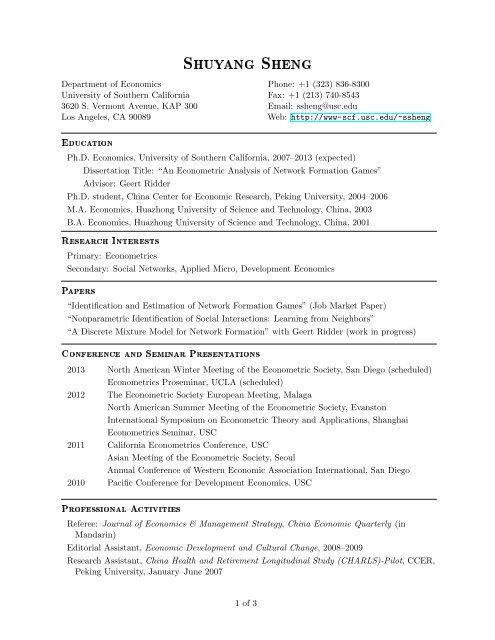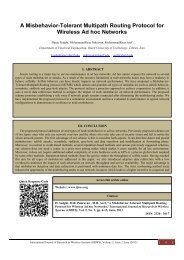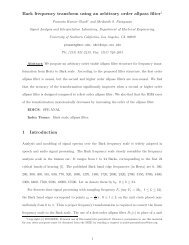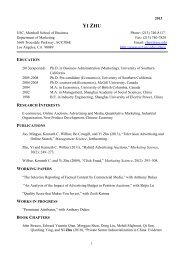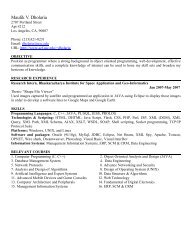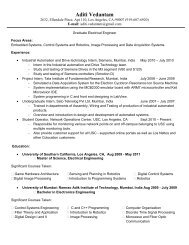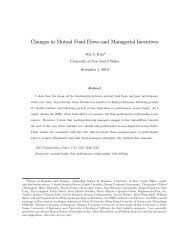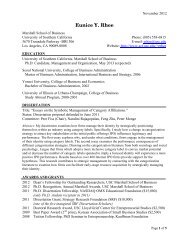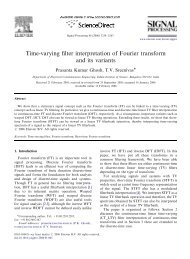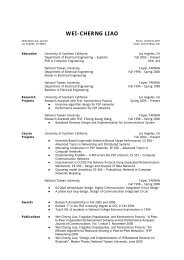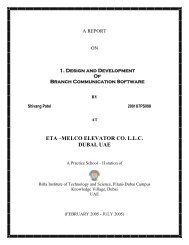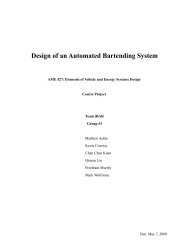Shuyang Sheng - University of Southern California
Shuyang Sheng - University of Southern California
Shuyang Sheng - University of Southern California
Create successful ePaper yourself
Turn your PDF publications into a flip-book with our unique Google optimized e-Paper software.
Department <strong>of</strong> Economics<br />
<strong>University</strong> <strong>of</strong> <strong>Southern</strong> <strong>California</strong><br />
3620 S. Vermont Avenue, KAP 300<br />
Los Angeles, CA 90089<br />
<br />
<br />
Phone: +1 (323) 836-8300<br />
Fax: +1 (213) 740-8543<br />
Email: ssheng@usc.edu<br />
Web: http://www-scf.usc.edu/~ssheng<br />
Ph.D. Economics, <strong>University</strong> <strong>of</strong> <strong>Southern</strong> <strong>California</strong>, 2007–2013 (expected)<br />
Dissertation Title: “An Econometric Analysis <strong>of</strong> Network Formation Games”<br />
Advisor: Geert Ridder<br />
Ph.D. student, China Center for Economic Research, Peking <strong>University</strong>, 2004–2006<br />
M.A. Economics, Huazhong <strong>University</strong> <strong>of</strong> Science and Technology, China, 2003<br />
B.A. Economics, Huazhong <strong>University</strong> <strong>of</strong> Science and Technology, China, 2001<br />
<br />
Primary: Econometrics<br />
Secondary: Social Networks, Applied Micro, Development Economics<br />
<br />
“Identification and Estimation <strong>of</strong> Network Formation Games” (Job Market Paper)<br />
“Nonparametric Identification <strong>of</strong> Social Interactions: Learning from Neighbors”<br />
“A Discrete Mixture Model for Network Formation” with Geert Ridder (work in progress)<br />
<br />
2013 North American Winter Meeting <strong>of</strong> the Econometric Society, San Diego (scheduled)<br />
Econometrics Proseminar, UCLA (scheduled)<br />
2012 The Econometric Society European Meeting, Malaga<br />
North American Summer Meeting <strong>of</strong> the Econometric Society, Evanston<br />
International Symposium on Econometric Theory and Applications, Shanghai<br />
Econometrics Seminar, USC<br />
2011 <strong>California</strong> Econometrics Conference, USC<br />
Asian Meeting <strong>of</strong> the Econometric Society, Seoul<br />
Annual Conference <strong>of</strong> Western Economic Association International, San Diego<br />
2010 Pacific Conference for Development Economics, USC<br />
<br />
Referee: Journal <strong>of</strong> Economics & Management Strategy, China Economic Quarterly (in<br />
Mandarin)<br />
Editorial Assistant, Economic Development and Cultural Change, 2008–2009<br />
Research Assistant, China Health and Retirement Longitudinal Study (CHARLS)-Pilot, CCER,<br />
Peking <strong>University</strong>, January–June 2007<br />
1 <strong>of</strong> 3
Teaching Assistant at USC<br />
Ph.D. Courses<br />
Econometrics Method for Roger Moon Spring 2011<br />
Economic and Financial Time Series I for Hashem Pesaran Spring 2010, 2011<br />
Applied Econometrics for Cheng Hsiao Fall 2010<br />
Undergraduate Courses<br />
Introduction to Econometrics for Cheng Hsiao Fall 2010<br />
Intermediate Macroeconomic Theory for Jeffrey Nugent Spring 2010<br />
Intermediate Microeconomic Theory for Shelkh Shahnawaz Fall 2009<br />
Teaching Assistant at Peking <strong>University</strong><br />
Intermediate Microeconomics for Yaohui Zhao Fall 2005<br />
<br />
2012 – 2013 Dissertation Completion Fellowship, USC<br />
2012 Gold Family Graduate Fellowship, USC<br />
2011, 2012 Summer Research Fellowship, Department <strong>of</strong> Economics, USC<br />
2011, 2012 Conference Travel Grant, GPSS, USC<br />
2011 Outstanding TA Award, Department <strong>of</strong> Economics, USC<br />
2010 Best Third Year Paper Award, Department <strong>of</strong> Economics, USC<br />
2008 Graduate Student Summer Fieldwork Grant, US-China Institute, USC<br />
2007 – 2012 College Graduate Merit Award, USC<br />
<br />
Scientific Workplace, Matlab, Stata, C, Linux<br />
<br />
Citizenship: China (F-1 Visa)<br />
Birthday: December 1981<br />
<br />
Geert Ridder (Chair)<br />
Pr<strong>of</strong>essor <strong>of</strong> Economics<br />
E-mail: ridder@usc.edu<br />
Phone: (213)740-3511<br />
Hyungsik Roger Moon<br />
Pr<strong>of</strong>essor <strong>of</strong> Economics<br />
E-mail: moonr@usc.edu<br />
Phone: (213)740-2108<br />
2 <strong>of</strong> 3<br />
Cheng Hsiao<br />
Pr<strong>of</strong>essor <strong>of</strong> Economics<br />
E-mail: chsiao@usc.edu<br />
Phone: (213)740-2103<br />
John Strauss<br />
Pr<strong>of</strong>essor <strong>of</strong> Economics<br />
E-mail: jstrauss@usc.edu<br />
Phone: (213)740-7698
“Identification and Estimation <strong>of</strong> Network Formation Games” (Job Market Paper)<br />
Social and economic networks play an important role in shaping individual behaviors. In this<br />
paper, we aim to identify and estimate network formation games using observed data on network<br />
structure, i.e., who is linked with whom. We use pairwise stability, introduced by Jackson and<br />
Wolinsky (1996), as the equilibrium condition to map observed networks to model primitives.<br />
Because the fraction <strong>of</strong> unique equilibria is close to zero, the model is generally not identified. We<br />
leave the equilibrium selection completely unrestricted and resort to partial identification.<br />
Following Ciliberto and Tamer (2009), we derive from the pairwise stability condition bounds on<br />
the probability <strong>of</strong> observing a network. The moment inequalities obtained from these bounds,<br />
however, are computationally infeasible if networks are large. To proceed, we propose a novel<br />
approach based on subnetworks. A subnetwork is the restriction <strong>of</strong> a network to a subset <strong>of</strong> the<br />
individuals. We derive bounds on the probability <strong>of</strong> observing a subnetwork, considering only the<br />
pairwise stability <strong>of</strong> the subnetwork. Under a local externality assumption about the utility<br />
function, these new bounds yield moment inequalities that are computationally feasible provided<br />
that we only use small subnetworks. We define the identified set based on the feasible moment<br />
inequalities and discuss how to consistently estimate the identified set and construct a confidence<br />
region. When estimating the distribution <strong>of</strong> subnetworks, we use graph isomorphism to group the<br />
subnetworks into equivalence classes to avoid the labeling problem and to resolve the<br />
indeterminacy in picking the subnetworks from a network. The bounds are computed by<br />
simulation if they do not have closed forms.<br />
Last updated December 5, 2012<br />
3 <strong>of</strong> 3


